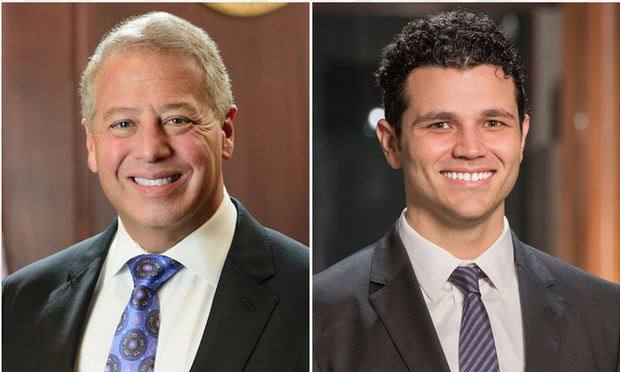#MeToo Wave Has Employers (and Their Insurers) Running for Cover
Following the wave of attention garnered by high-profile cases involving sexual harassment and assault allegations against supervisors, employers are seeking out whatever help they can to prevent similar conduct from occurring under their watch.
March 26, 2018 at 03:30 PM
6 minute read
 Brian S. Kabateck, the founding and managing partner of Kabateck Brown Kellner and associate Nicholas R. Moreno
Brian S. Kabateck, the founding and managing partner of Kabateck Brown Kellner and associate Nicholas R. Moreno
Following the wave of attention garnered by high-profile cases involving sexual harassment and assault allegations against supervisors, employers are seeking out whatever help they can to prevent similar conduct from occurring under their watch. Employers try to limit their risk in a number of ways including purchasing employment practices liability insurance (EPLI) or by implementing policies that include education and internal dispute resolution processes to prevent and resolve sexual harassment disputes.
The legal fallout from workplace sexual harassment cost U.S. companies an estimated $2.2 billion on insurance policies alone in 2016, according to insurance analytics firm MarketStance. Insurance giant Nationwide reported a 15 percent jump in EPLI from fall 2016 to September 2017, which coincides with the sexual harassment scandals that ousted Roger Ailes and Bill O'Reilly from Fox News.
These policies provide coverage for companies and their employees, including senior management, for claims brought by past, present or future employees claiming sexual misconduct in the workplace including quid pro quo and hostile work environment. Most policies will also extend coverage to claims brought by third parties, such as clients or customers. However, they almost certainly will exclude claims involving an employee's intentional conduct and/or bodily injury (e.g., sexual assault). Some EPLI policies also include exclusions that distinguish between behavior that is insurable and behavior that is so egregious that to insure it would be offensive and contrary to public policy.
Employers should take note, these policies will not cover punitive damages in California and perhaps elsewhere. And, when these cases are put in front of a jury, punitive damages can be huge and devastating. Just in the last few weeks there have been two large verdicts in workplace sexual harassment cases. In New York, a sugar refinery got hit with a $13.4 million verdict with $11.7 million in punitive damages after their human resources failed to address the continued harassment of an employee by a supervisor. In the other, in California, the jury returned a $2.6 million verdict with $1.1 million in punitive damages against a fabric company who failed to take appropriate action when one employee spread rumors about another employee's sexuality. In both cases, the harassment was pervasive and continuous and demonstrated the complete failure by the human resources departments to assess and fully appreciate the seriousness of its employees' misconduct.
Laws prohibiting various forms of sexual harassment have been on the books for decades. In 1986, the U.S. Supreme Court held that Title VII of the Civil Rights Act of 1964 protected workers from sexual harassment in the workplace, reasoning that a claim of hostile work environment sexual harassment is a form of discrimination. Meritor Savings Bank v. Vinson, 477 U.S. 57 (1986). Prior to that decision, the Equal Employment Opportunity Commission defined sexual harassment as unwelcome sexual advances and other conduct of a sexual nature that interferes with an individual's work performance. These principles were expanded to hold employers vicariously liable for the discriminatory conduct of their supervisors.
California, always a leader on social issues, enacted the Fair Employment and Housing Act in 1959, which made sexual harassment illegal in the workplace. Since its enactment, FEHA has been amended several times to require employers to provide their employees with sexual harassment and discrimination education and training. The most recent amendment, SB 396, is remarkable in that it required any sexual harassment training to include discussions of gender identity, gender expression, and sexual orientation. See, e.g., Cal. Gov. Code Section 12950.1; see also Unemployment Ins. Code Section 14005(j)(14). This progress is encouraging, but as history demonstrates, the laws prohibiting sexual harassment do not necessarily translate to different outcomes in the workplace. The laws still need to be enforced and the concepts learned in sexual harassment education still need to be implemented. This can only happen with more diverse workforces that shift the culture.
As of now, workplace culture is a culture of silence—a reluctance by a victim or witnesses to speak out against sexual harassment. To make matters worse, this reluctance is built into and encouraged by the law. For example, without fail, any action for sexual harassment will be resolved in a confidential mandatory arbitration proceeding. Then, if the claims are settled, the settlement is always subject to a nondisclosure agreement, which, if breached, would subject the victim to liability. Courts will uphold these nondisclosures if they are “reasonable” (i.e., the agreement does not violate public policy or conceal criminal conduct). This is a low standard as evidenced by the frequency of which these agreements are utilized.
As the culture has shifted towards more inclusive definitions of harassment and tolerance for such behavior continues to plummet, the time will come when nondisclosure agreements and secret settlements of claims for sexual harassment will be called into question. In the meantime, verdicts will continue to rise as juries assess punitive damages against employers who show a lack of understanding of sexual harassment as a major issue.
With the rise of the #MeToo movement, more women have come forward to share their experiences of being sexually harassed by co-workers and new surveys find the prevalence of this behavior is staggering. According to a Marketplace-Edison research poll, 46 percent of women reported experiencing such workplace harassment by a boss or co-worker that it caused them to leave their jobs or switch careers.
While employers are seeking ways to limit their own exposure to liability, they're also turning to training programs to change the behavior of their employees. But offering crash courses on sexual harassment will only go as far as employees and supervisors feel comfortable using them. The key to combating discrimination and harassment among co-workers is by having diversity in the workplace. When there are diverse backgrounds within a workplace, the cultural competency of the entire group is elevated. This competency leads to a certain level of openness and transparency that allows employees to encounter different viewpoints including new attitudes toward sexual harassment.
Brian S. Kabateck is the founding and managing partner of Kabateck Brown Kellner. His expertise is in the areas of personal injury, insurance bad faith, pharmaceutical litigation, wrongful death, class action, mass torts and disaster litigation.
Nicholas R. Moreno is an associate with the firm handling a wide range of cases including consumer class actions, mass torts and insurance bad faith claims.
This content has been archived. It is available through our partners, LexisNexis® and Bloomberg Law.
To view this content, please continue to their sites.
Not a Lexis Subscriber?
Subscribe Now
Not a Bloomberg Law Subscriber?
Subscribe Now
NOT FOR REPRINT
© 2025 ALM Global, LLC, All Rights Reserved. Request academic re-use from www.copyright.com. All other uses, submit a request to [email protected]. For more information visit Asset & Logo Licensing.
You Might Like
View All



Trending Stories
- 1Some Thoughts on What It Takes to Connect With Millennial Jurors
- 2Artificial Wisdom or Automated Folly? Practical Considerations for Arbitration Practitioners to Address the AI Conundrum
- 3The New Global M&A Kings All Have Something in Common
- 4Big Law Aims to Make DEI Less Divisive in Trump's Second Term
- 5Public Notices/Calendars
Who Got The Work
J. Brugh Lower of Gibbons has entered an appearance for industrial equipment supplier Devco Corporation in a pending trademark infringement lawsuit. The suit, accusing the defendant of selling knock-off Graco products, was filed Dec. 18 in New Jersey District Court by Rivkin Radler on behalf of Graco Inc. and Graco Minnesota. The case, assigned to U.S. District Judge Zahid N. Quraishi, is 3:24-cv-11294, Graco Inc. et al v. Devco Corporation.
Who Got The Work
Rebecca Maller-Stein and Kent A. Yalowitz of Arnold & Porter Kaye Scholer have entered their appearances for Hanaco Venture Capital and its executives, Lior Prosor and David Frankel, in a pending securities lawsuit. The action, filed on Dec. 24 in New York Southern District Court by Zell, Aron & Co. on behalf of Goldeneye Advisors, accuses the defendants of negligently and fraudulently managing the plaintiff's $1 million investment. The case, assigned to U.S. District Judge Vernon S. Broderick, is 1:24-cv-09918, Goldeneye Advisors, LLC v. Hanaco Venture Capital, Ltd. et al.
Who Got The Work
Attorneys from A&O Shearman has stepped in as defense counsel for Toronto-Dominion Bank and other defendants in a pending securities class action. The suit, filed Dec. 11 in New York Southern District Court by Bleichmar Fonti & Auld, accuses the defendants of concealing the bank's 'pervasive' deficiencies in regards to its compliance with the Bank Secrecy Act and the quality of its anti-money laundering controls. The case, assigned to U.S. District Judge Arun Subramanian, is 1:24-cv-09445, Gonzalez v. The Toronto-Dominion Bank et al.
Who Got The Work
Crown Castle International, a Pennsylvania company providing shared communications infrastructure, has turned to Luke D. Wolf of Gordon Rees Scully Mansukhani to fend off a pending breach-of-contract lawsuit. The court action, filed Nov. 25 in Michigan Eastern District Court by Hooper Hathaway PC on behalf of The Town Residences LLC, accuses Crown Castle of failing to transfer approximately $30,000 in utility payments from T-Mobile in breach of a roof-top lease and assignment agreement. The case, assigned to U.S. District Judge Susan K. Declercq, is 2:24-cv-13131, The Town Residences LLC v. T-Mobile US, Inc. et al.
Who Got The Work
Wilfred P. Coronato and Daniel M. Schwartz of McCarter & English have stepped in as defense counsel to Electrolux Home Products Inc. in a pending product liability lawsuit. The court action, filed Nov. 26 in New York Eastern District Court by Poulos Lopiccolo PC and Nagel Rice LLP on behalf of David Stern, alleges that the defendant's refrigerators’ drawers and shelving repeatedly break and fall apart within months after purchase. The case, assigned to U.S. District Judge Joan M. Azrack, is 2:24-cv-08204, Stern v. Electrolux Home Products, Inc.
Featured Firms
Law Offices of Gary Martin Hays & Associates, P.C.
(470) 294-1674
Law Offices of Mark E. Salomone
(857) 444-6468
Smith & Hassler
(713) 739-1250






